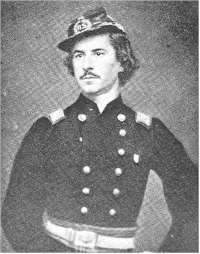By Dick Crews
The Cleveland Civil War Roundtable
Copyright © 2008, All Rights Reserved
Editor’s note: This article was originally published in The Charger in the winter of 2001.
A strange sight on a Civil War battlefield was the Zouaves. In the Civil War, where a marksman could drop a soldier from a 1,000 yards away, the Zouaves were dressed in gaudy reds and blues. There were Zouave regiments in both the Southern as well as the Northern Army. The famous units were the 5th New York, 114th Pennsylvania, 14th Brooklyn, and 1st Louisiana.

The 1st Louisiana “Wheat’s Tigers” was the most famous Confederate Zouaves. “Wheat’s Tigers” were recruited from the docks of New Orleans by soldier of fortune Roberdeau Wheat. This unit has been described as being full of adventurous wharf rats, thieves, and cutthroats.
Who were the Zouaves and where did they come from? The name comes from the Zouaouas, a fierce tribe living in the rocky hills of Algeria and Morocco. In 1830, the tribe tendered their services to the French Army and proved their valor in dozens of bloody desert battles. Over time the Zouave units became filled with native Frenchman but the uniforms did not change.
A young Army Captain George B. McClellan observing the Zouaves in 1855 praised them as “the finest light infantry that Europe can produce; the beau-ideal of a soldier.” American militia units soon began to adopt the baggy trousers, braided jacket, and tasseled fez of the Zouave uniform.
Most historians give Elmer Ellsworth credit for the American Zouave craze. Ellsworth was the first Union officer to die in the Civil War. He being a friend of President Lincoln, his body was placed in state in the East Room of the White House. “Avenge Ellsworth!” became the North’s cry.
Ellsworth toured the United States, including Cleveland, in 1860 to show off his Chicago Zouaves as the best drill team in the country. He outfitted his cadets in a Zouave uniform of his design and drilled them using tactics from French manuals.

Roberdeau Wheat 
Elmer Ellsworth
In 1861, Ellsworth traveled to Washington, D.C. to watch his friend Abraham Lincoln inaugurated as President. He then traveled to New York City to raise a regiment of Zouaves. He recruited from the city’s volunteer fire department. In two weeks he formed the 11th New York Infantry.
After a parade down Broadway on April 29, 1861, the New York 11th headed for Washington. The unit received a personal welcome from President Lincoln. The President’s secretary, John Hay, described them as “ a jolly, gay set of Blackguards.”
In fact, Ellsworth had his hands full trying to control the hard-drinking New York fireman. Because of this contacts with Lincoln, he was able to get his unit to be part of the raiding party to take Alexandria, Virginia across the Potomac River from Washington.
In Alexandria he spotted a Confederate flag flying from a local hotel. After taking down the flag, Ellsworth was shot dead. The shooter, the hotel owner, was quickly killed by Ellsworth’s troops but now the North had a martyr, Elmer Ellsworth.

The connection with volunteer fire departments spread and soon more New York and Philadelphia Zouave units were formed. The most famous of these units was the New York 5th, mostly fireman, mostly Irish. “Duryee’s Zouaves,” as they were called, were originally under the command of Colonel Abram Duryee. The New York 5th fought at Big Bethel, Yorktown, Gaines’ Mill, Second Manassas (where the unit took its highest causalities), Fredericksburg, and Chancellorsville. Following Chancellorsville their two-year enlistment was up, and they returned to New York with a parade down Broadway.

In general, the Zouaves in the Civil War were good troops but not exceptional. These American volunteers selected to be dressed in Zouave uniforms. In the French Army soldiers were selected for the elite Zouave Units.
The Zouaves were part of the French Army until World War I. The first charge of one Zouave unit in 1914 resulted in 80% causalities. By 1915, all French soldiers were in helmets and uniforms of army green.
The Zouaves confronting machine guns with chivalry faded into history in 1914.
